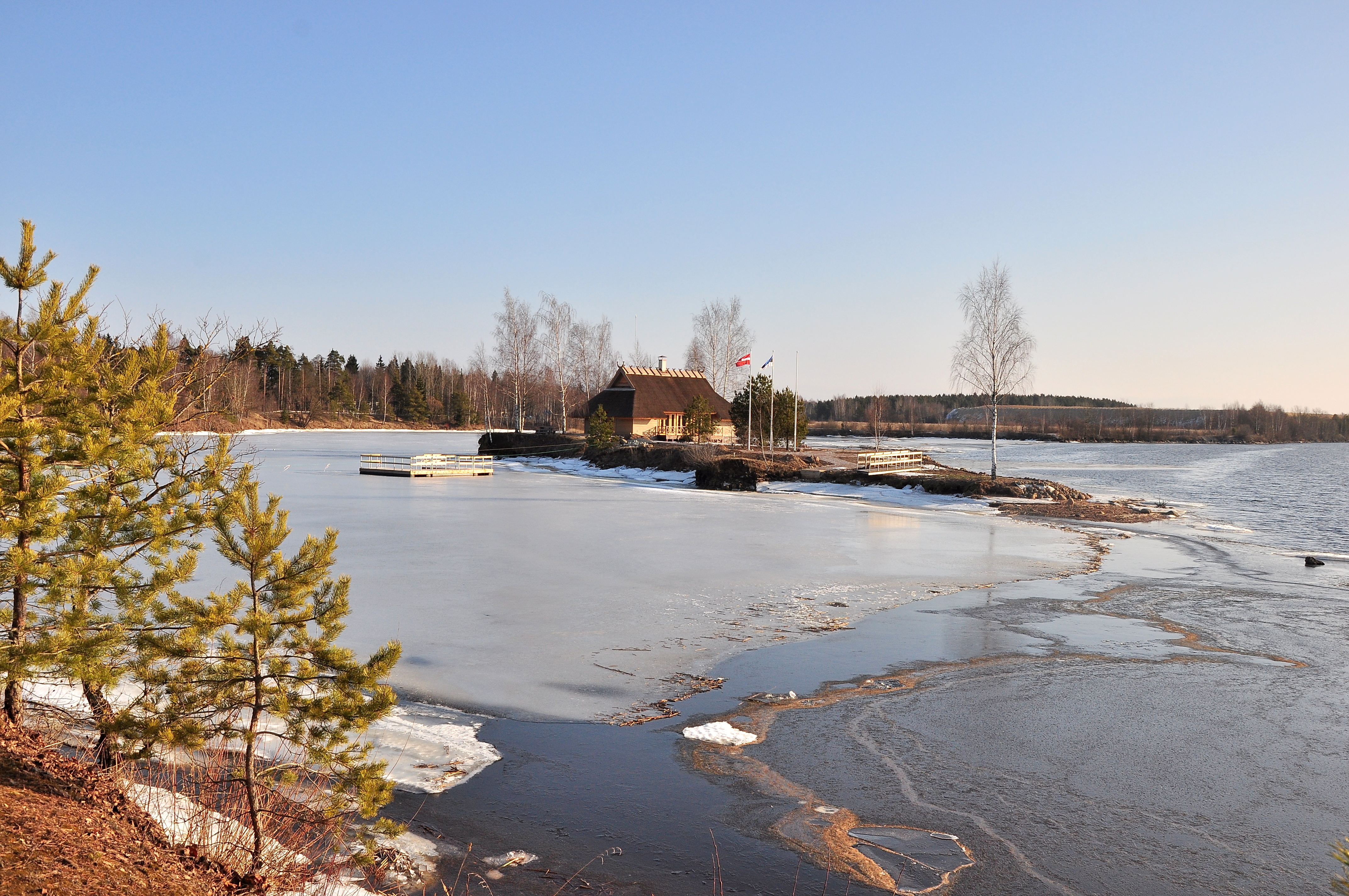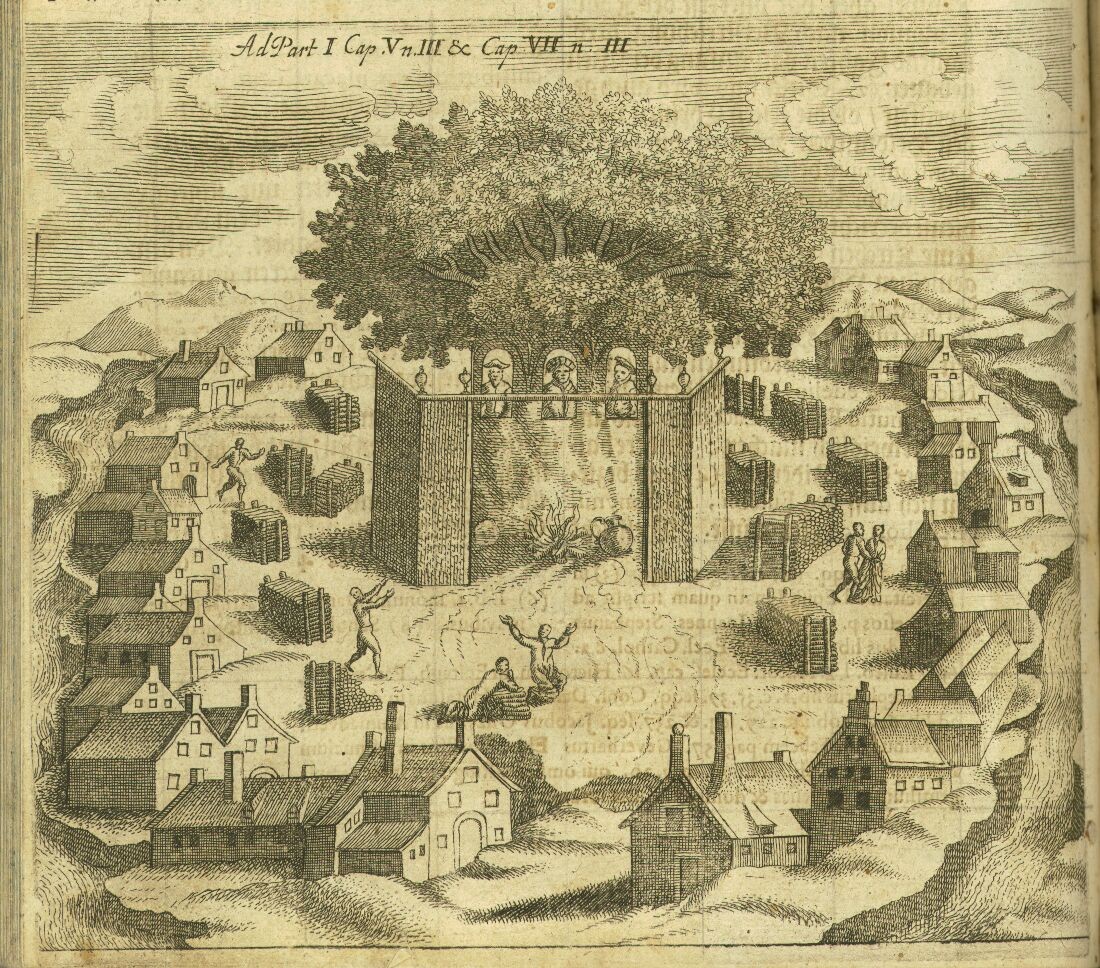|
Lokstene Shrine Of Dievturi
Lokstene Shrine of Dievturi ( lv, Lokstenes dievturu svētnīca) is a Dievturi religious building in Aizkraukle Municipality, in the Vidzeme region of Latvia. It was inaugurated in 2017 and is used by the organization Latvijas Dievturu sadraudze for devotional ceremonies and annual celebrations. History The project to build a modern shrine for Baltic paganism was initiated and financed by Dagnis Čākurs, owner of the Liepkalni bakery chain. Čākurs explained that as he had grown older, he had become more interested in questions about the soul and mortality. As the Latvian people had supported his business over the years, he wanted to give something in return, and hoped to do so with a house for the national gods and Latvian folk culture. He attributed his interest in Latvian paganism to Valdis Celms, an artist, author and leading member of the Baltic neopagan organization Latvijas Dievturu sadraudze (LDS). The Lokstene Shrine was constructed on an island owned by Čāku ... [...More Info...] [...Related Items...] OR: [Wikipedia] [Google] [Baidu] |
Klintaine Parish
Klintaine Parish ( lv, Klintaines pagasts) is an administrative unit of Aizkraukle Municipality in the Vidzeme Vidzeme (; Old Latvian orthography: ''Widda-semme'', liv, Vidūmō) is one of the Historical Latvian Lands. The capital of Latvia, Riga, is situated in the southwestern part of the region. Literally meaning "the Middle Land", it is situated in ... region of Latvia. As of 2011 population of Klintaine Parish is 855 people. Towns, villages and settlements of Klintaine Parish * Alkšņi * Čulkstēni * Dīķīši * Klintaine * Mūrnieki * Rīteri *Salas * Stukmaņi * Sturti * Zemlejas Parishes of Latvia Aizkraukle Municipality Vidzeme {{vidzeme-geo-stub ... [...More Info...] [...Related Items...] OR: [Wikipedia] [Google] [Baidu] |
Pļaviņas
Pļaviņas (; german: Stockmannshof) is a town in Aizkraukle Municipality in Latvia. The town is located on the Daugava river. The population in 2020 was 2,974. Latvian law defines the town of Pļaviņas as belonging partly to the Vidzeme region and partly to Latgale. Latviešu vēsturisko zemju likums See also * List of cities in Latvia *Pļaviņas municipality
Pļaviņas Municipality ( lv, Pļaviņu novads) is a former municipality in Vidzeme, Latvia. The municipality was formed in 2009 by merging Aiviekste parish, Klintaine parish, Vietalva parish and Pļaviņas town th ...
[...More Info...] [...Related Items...] OR: [Wikipedia] [Google] [Baidu] |
Religious Buildings And Structures In Latvia
Religion is usually defined as a social-cultural system of designated behaviors and practices, morals, beliefs, worldviews, texts, sanctified places, prophecies, ethics, or organizations, that generally relates humanity to supernatural, transcendental, and spiritual elements; however, there is no scholarly consensus over what precisely constitutes a religion. Different religions may or may not contain various elements ranging from the divine, sacred things, faith,Tillich, P. (1957) ''Dynamics of faith''. Harper Perennial; (p. 1). a supernatural being or supernatural beings or "some sort of ultimacy and transcendence that will provide norms and power for the rest of life". Religious practices may include rituals, sermons, commemoration or veneration (of deities or saints), sacrifices, festivals, feasts, trances, initiations, funerary services, matrimonial services, meditation, prayer, music, art, dance, public service, or other aspects of human culture. Religions ha ... [...More Info...] [...Related Items...] OR: [Wikipedia] [Google] [Baidu] |
Modern Paganism In Latvia
Modern may refer to: History * Modern history ** Early Modern period ** Late Modern period *** 18th century *** 19th century *** 20th century ** Contemporary history * Moderns, a faction of Freemasonry that existed in the 18th century Philosophy and sociology * Modernity, a loosely defined concept delineating a number of societal, economic and ideological features that contrast with "pre-modern" times or societies ** Late modernity Art * Modernism ** Modernist poetry * Modern art, a form of art * Modern dance, a dance form developed in the early 20th century * Modern architecture, a broad movement and period in architectural history * Modern music (other) Geography *Modra, a Slovak city, referred to in the German language as "Modern" Typography * Modern (typeface), a raster font packaged with Windows XP * Another name for the typeface classification known as Didone (typography) * Modern, a generic font family name for fixed-pitch serif and sans serif fonts ( ... [...More Info...] [...Related Items...] OR: [Wikipedia] [Google] [Baidu] |
Religious Buildings And Structures Completed In 2017
Religion is usually defined as a social-cultural system of designated behaviors and practices, morals, beliefs, worldviews, texts, sanctified places, prophecies, ethics, or organizations, that generally relates humanity to supernatural, transcendental, and spiritual elements; however, there is no scholarly consensus over what precisely constitutes a religion. Different religions may or may not contain various elements ranging from the divine, sacred things, faith,Tillich, P. (1957) ''Dynamics of faith''. Harper Perennial; (p. 1). a supernatural being or supernatural beings or "some sort of ultimacy and transcendence that will provide norms and power for the rest of life". Religious practices may include rituals, sermons, commemoration or veneration (of deities or saints), sacrifices, festivals, feasts, trances, initiations, funerary services, matrimonial services, meditation, prayer, music, art, dance, public service, or other aspects of human culture. Religions ha ... [...More Info...] [...Related Items...] OR: [Wikipedia] [Google] [Baidu] |
Baltic Modern Paganism
Baltic may refer to: Peoples and languages *Baltic languages, a subfamily of Indo-European languages, including Lithuanian, Latvian and extinct Old Prussian *Balts (or Baltic peoples), ethnic groups speaking the Baltic languages and/or originating from the Baltic countries *Baltic Germans, historical ethnic German minority in Latvia and Estonia *Baltic Finnic peoples, the Finnic peoples historically inhabiting the area on the northeastern side of the Baltic sea Places Northern Europe * Baltic Sea, in Europe * Baltic region, an ambiguous term referring to the general area surrounding the Baltic Sea * Baltic states (also Baltic countries, Baltic nations, Baltics), a geopolitical term, currently referring to Estonia, Latvia and Lithuania * Baltic Provinces or governorates, former parts of the Swedish Empire and then Russian Empire (in modern Latvia, Estonia) * Baltic Shield, the exposed Precambrian northwest segment of the East European Craton * Baltic Plate, an ancient tectonic pla ... [...More Info...] [...Related Items...] OR: [Wikipedia] [Google] [Baidu] |
Romuva (temple)
Romuva or Romowe (also known as Rickoyoto in the writings of Simon Grunau) was an alleged pagan worship place (a temple or a sacred area) in the western part of Sambia, one of the regions of pagan Prussia. In contemporary sources the temple is mentioned only once, by Peter von Dusburg in 1326. According to his account, Kriwe-Kriwajto, the chief priest or "pagan pope", lived at Romuva and ruled over the religion of all the Balts. According to Simon Grunau, the temple was central to Prussian mythology. Even though there are considerable doubts whether such a place actually existed, the Lithuanian neo-pagan movement '' Romuva'' borrowed its name from the temple. Historical accounts According to Peter von Dusburg, writing in 1326, the name ''Romuva'' is derived from the word Rome. He describes the Kriwe as a powerful priest who was held in high regard by the Prussians, Lithuanians, and Balts of Livonia. His messengers were recognized by a certain rod or other insignia. He guarded th ... [...More Info...] [...Related Items...] OR: [Wikipedia] [Google] [Baidu] |
Interior Design
Interior design is the art and science of enhancing the interior of a building to achieve a healthier and more aesthetically pleasing environment for the people using the space. An interior designer is someone who plans, researches, coordinates, and manages such enhancement projects. Interior design is a multifaceted profession that includes conceptual development, space planning, site inspections, programming, research, communicating with the stakeholders of a project, construction management, and execution of the design. History and current terms In the past, interiors were put together instinctively as a part of the process of building.Pile, J., 2003, Interior Design, 3rd edn, Pearson, New Jersey, USA The profession of interior design has been a consequence of the development of society and the complex architecture that has resulted from the development of industrial processes. The pursuit of effective use of space, user well-being and functional design has contributed ... [...More Info...] [...Related Items...] OR: [Wikipedia] [Google] [Baidu] |
Daugava
, be, Заходняя Дзвіна (), liv, Vēna, et, Väina, german: Düna , image = Fluss-lv-Düna.png , image_caption = The drainage basin of the Daugava , source1_location = Valdai Hills, Russia , mouth_location = Gulf of Riga, Baltic Sea , mouth_coordinates = , subdivision_type1 = Country , subdivision_name1 = Belarus, Latvia, Russia , length = , source1_elevation = , mouth_elevation = , discharge1_avg = , basin_size = , pushpin_map = , pushpin_map_size = , pushpin_map_caption = , pushpin_map_alt = The Daugava ( ltg, Daugova; german: Düna) or Western Dvina (russian: Западная Двина, translit=Západnaya Dviná; be, Заходняя Дзвіна; et, Väina; fi, Väinäjoki) is a large river rising in the Valdai Hills of Russia that flows through Belarus and Latvia into the Gulf of Riga of the Baltic Sea. It rises close to the source of the Volga. It is in length, of which are in Latvia and are in Russia. It is a westward-flowing river, t ... [...More Info...] [...Related Items...] OR: [Wikipedia] [Google] [Baidu] |
Dievturība
Dievturība is a neopagan movement which is a modern revival of the ethnic religion of the Latvians before Christianization in the 13th century. Adherents call themselves Dievturi (singular: Dievturis), literally "Dievs' keepers", "people who live in harmony with Dievs". The movement is mainly based on Latvian folklore, folk songs and Latvian mythology. The Dievturi movement was founded in 1925 by Ernests Brastiņš and Kārlis Marovskis-Bregžis. It was forcibly suppressed by Soviets in 1940, but lived on in émigré communities and was re-registered in Latvia in 1990. In 2016, a social media survey found that 20% of Latvians identified their religious affiliation as "Latvian religion."Nastevics, Ugis. (2018). Latvian Religion – Dievturība?. Religiski-Filozofiski Raksti. XXIV. 82-104. Of those 20%, 81% who declared themselves “dievturis”, 1% “Dievs, Laima, Māra – folk religion”, 9% “latviskā dzīvesziņa (‘Latvian worldview’)”, 6% “a Latvian”, 2% � ... [...More Info...] [...Related Items...] OR: [Wikipedia] [Google] [Baidu] |
Latvijas Avīze
''Latvijas Avīze'' (''Latvian Newspaper'') is a national conservative Latvian language national daily newspaper in Latvia, published in Riga. The Latvian word ''avīze'' ('newspaper' or 'journal') is a loanword and cognate with the French word ''avis'', meaning opinion, notice and advice. History In January 1988, the newspaper ''Lauku Avīze'' ('Rural Newspaper') was first published in Soviet-occupied Latvia. After the restoration of Latvian independencem in 1991 the AS ''Lauku Avīze'' (since 2017 - AS ''Latvijas Mediji'') publishing house was established. In 2003, "Lauku Avīze" was renamed "Latvijas Avīze". In 2013, the publishing house worked with a profit of 23,140 euros and a turnover of 4,855,528 euros. In 2013, compared to 2012, the paper earned three times more, but the turnover decreased by 2%. About the newspaper ''Latvijas Avīze'' reflects and analyzes social and political events and other developments in Latvia and the world every day. The newspaper won t ... [...More Info...] [...Related Items...] OR: [Wikipedia] [Google] [Baidu] |






